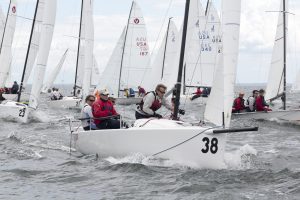
It’s hard to make a rule of thumb about what to do on beats in big fleets because the relevant mix of variables is always unique and changing. © Barry Hyman
A J/24 World Championship several years ago featured a fleet of 100 boats and produced some classic big-fleet competition. Racing in a large fleet like this is quite a different game than sailing with only 20 or 30 boats. It brings a whole new set of factors and priorities that you must consider. Here’s a closer look at some strategic implications.
General principles
There are two basic qualities that separate a large fleet from a small fleet. First, and foremost, there are more boats on the course. This may seem obvious, but the presence and proximity of numerous boats will affect your tactics, strategy and speed more than any other factor.
The second characteristic is that, in a big fleet, almost everything is bigger or longer – the starting line, the windward legs and so on. Consequently, the boats spread farther apart, and there are bigger chances for gains (and losses). Because of these factors, you should follow certain rules of thumb when racing in a big fleet:
• Sail more conservatively. When you have a lot of traffic and boats are spread out across the course, the consequences of making mistakes are more severe. So, play the percentages. Stick to strategies that have the highest chance of success.
• Develop a well-thought-out strategy before and during the race, and then follow it. With a lot of boats and a large course, you won’t be able to change sides or adjust your gameplan as easily as you can with fewer boats. So, work harder at going the right way in the first place.
• Use aggressive tactics to stick to your strategy. In a large fleet you have fewer and smaller windows of opportunity to go where you want. Take full advantage of these, and try not to let other boats dictate where you sail.
• Don’t get caught up with just one or two competitors. In a large regatta you are racing against the fleet more than individual boats. So unless you are near the finish, don’t change your gameplan to maneuver against particular boats (e.g. don’t get into a luffing match). If you do this, you will end up losing to every other boat in the fleet.
• Go for consistency, not victory. At the end of most large regattas, the sailors at the top of the scoreboard are usually the ones who were the most consistent, not the ones who had the most first places. That J/24 Worlds was a good example. The boat that finished second overall (out of 100 boats) had an average score of just worse than 11th (not including their throwout)!
So don’t try to win every race. If your goal is to be first (or even to be in the top five) you will be tempted to take too much risk, and that could mean some really bad scores.
A reasonable goal might be to finish 10th in each race. Assuming you will catch a few boats during the race, this means you want to aim for 15th, or maybe even top 20, at the first windward mark. This will obviously lead you to take a very different, and more conservative, approach to the first beat than if you’re trying to win the race.
In a big fleet you should follow all the same rules of thumb that you use in a small fleet. But you have to adjust your thinking be- cause, with so many boats, it’s harder to stay on track and more important to avoid mistakes. ■
This article originally appeared in David Dellenbaugh’s Speed & Smarts, The newsletter of how-to tips for racing sailors. If you want to sail faster and smarter, log onto SpeedandSmarts.com.
A resident of Easton, CT, Dellenbaugh was tactician and starting helmsman for America3’s successful defense of the America’s Cup in 1992. He’s a Lightning World Champion, two-time Congressional Cup winner, seven-time Thistle National Champion, two-time winner of the Canada’s Cup, three-time Prince of Wales U.S. Match Racing Champion, and a winner of the U.S. Team Racing Championships for the Hinman Trophy.




